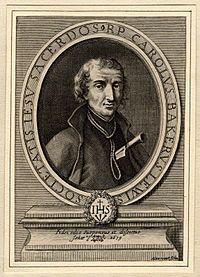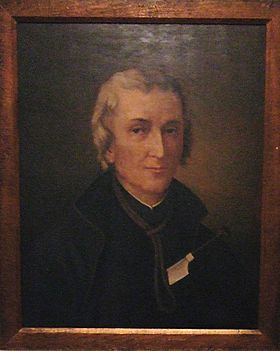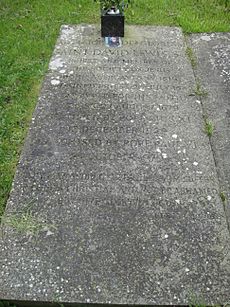David Lewis (Jesuit priest) facts for kids
Quick facts for kids SaintDavid Lewis SJ |
|
|---|---|

David Lewis, engraving by Alexander Voet (1683)
|
|
| Martyr | |
| Born | 1616 Abergavenny, Monmouthshire, Wales, Kingdom of England |
| Died | 27 August 1679 (aged 62–63) Usk, Monmouthshire, Wales |
| Venerated in | Catholic Church |
| Beatified | 15 December 1929 by Pope Pius XI |
| Canonized | 25 October 1970, Vatican City by Pope Paul VI |
| Feast | 27 August |
David Lewis (1616 – 27 August 1679) was a Jesuit Catholic priest. He was also known as Charles Baker. Lewis is remembered as a martyr because he died for his faith. In 1970, Pope Paul VI made him a saint. He is one of the Forty Martyrs of England and Wales. Catholics celebrate his special day, called a feast day, on 27 August.
Early Life and Calling
David Lewis was born in 1616 in Abergavenny, a town in Monmouthshire, Wales. He was the youngest of nine children. His father, Morgan Lewis, was an Anglican Reverend and a school headmaster. His mother, Margaret Pritchard, was Catholic. David's cousin, John Kemble, also became a martyr later on.
When David was 16, he visited Paris. There, he decided to become a Catholic, changing from his Anglican faith. After this, he went to study at the English College, Rome. While studying, he used the name "Charles Baker." This was a common practice for Catholic priests at the time. It helped them avoid spies and informers working for the government.
David Lewis became a Catholic priest on 20 July 1642. Three years later, he joined the Society of Jesus, a group of Catholic priests and brothers often called Jesuits.
He returned to Wales for a year. Then, he was asked to guide students at the English College in Rome. After finishing his work in Rome, he came back to Monmouthshire. For 30 years, he worked hard to help people. He especially cared for the poor and those in need. Because of his kindness, people called him Tad y Tlodion, which means "Father of the Poor" in Welsh.
Arrest and Trial
On 17 November 1678, David Lewis was arrested at St Michael's Church in Llantarnam. He was accused of being a Catholic priest and holding Catholic Masses. At that time, it was against the law in England to be a Catholic priest or to practice the Catholic faith openly.
He was also falsely accused of trying to harm King Charles II. People claimed he wanted to bring back the Catholic faith in Wales. An unfaithful couple betrayed him, hoping to get a reward of 50 pounds. A Welsh judge also promised 200 pounds to anyone who could help find him.
Like other priests, he was sent to London. There, he was questioned by Titus Oates. Oates was known for starting the "Popish Plot" – a false story about Catholics planning to overthrow the king. But Oates and his helpers could not prove anything against David Lewis.
David Lewis's trial took place in Monmouth on 16 March 1679. He was charged with high treason. This meant he was accused of a serious crime against the country. The charge was for becoming a Catholic priest and staying in England, which was against the law.
He said he was not guilty of being part of the "Popish Plot." However, several witnesses said they had seen him perform Mass and other priestly duties. Because of this, Lewis was found guilty and sentenced to death by Judge Sir Robert Atkyns.
Final Moments and Legacy
While in Newgate Prison in London, David Lewis was again questioned about the "plot." Important people, like Lord Shaftesbury, told him that if he admitted to the "plot" or gave up his Catholic faith, his life would be saved. He was even promised great rewards.
But David Lewis refused. In his last speech, he said he could not reveal a plot because he knew of none. He also said he would not change his faith because it was against his conscience.
The people who watched his execution, many of whom were Protestants, respected him greatly. They insisted that he be allowed to hang until he was truly dead and receive a proper burial. The Sheriff, who knew and liked Lewis, delayed the execution as long as he could. He even refused to attend it.
After the false "Popish Plot" accusations (1679–80), many Welsh-speaking Catholic priests were either executed or forced to leave the country. David Lewis was the last Welshman to become a Jesuit for over 300 years, until 2001.
Recognition
David Lewis was made a saint by Pope Paul VI in 1970. He was canonized along with John Wall, John Kemble, and 37 other martyrs. They are all known as the Forty Martyrs of England and Wales.
In November 2007, a special plaque was put up near Llantarnam Abbey. It marks the spot where David Lewis was arrested. The Catholic church in Usk is named St David Lewis and St Francis Xavier Church in his honor.



